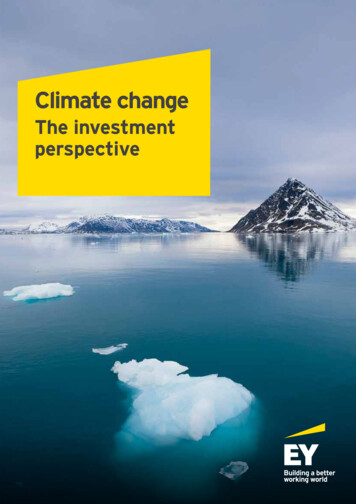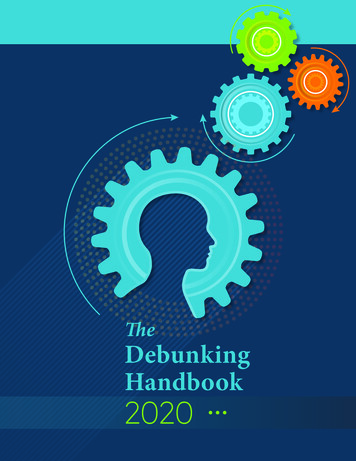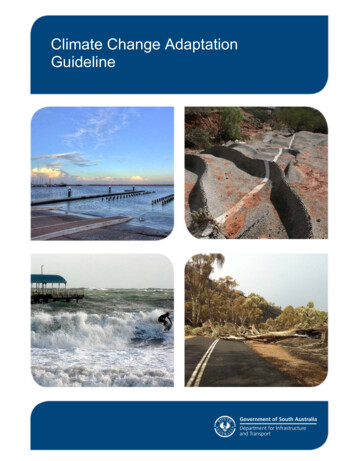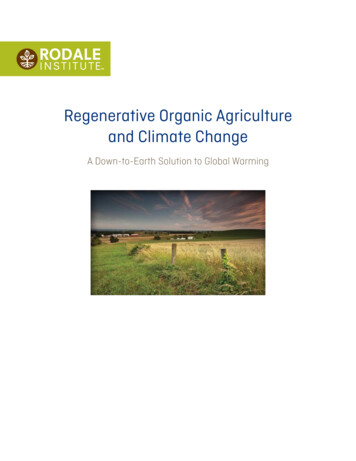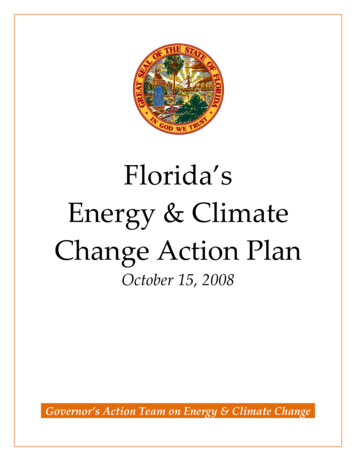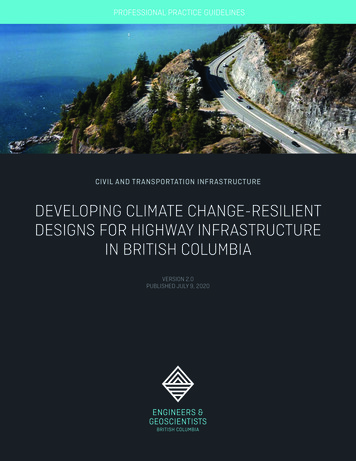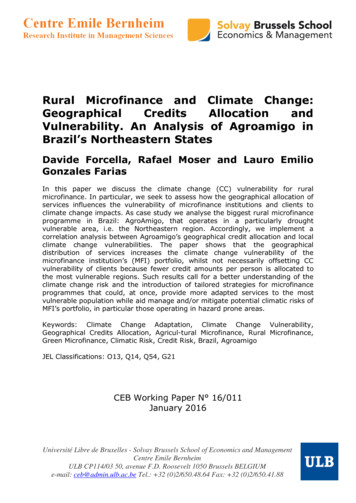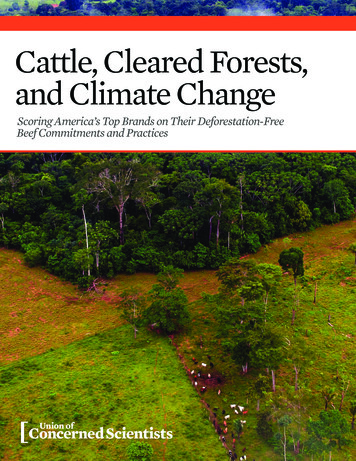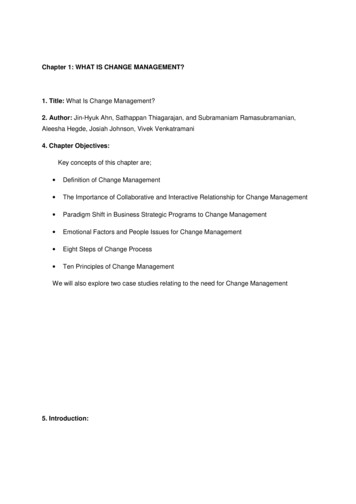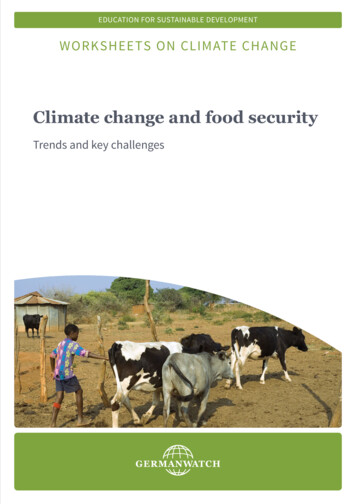
Transcription
EDUCATION FOR SUSTAINABLE DEVELOPMENTWORKSHEETS ON CLIMATE CHANGEClimate change and food securityTrends and key challenges
Climate change and food security – Trends and key challenges Germanwatch 2014Climate change and food securityTrends and key challengesClimate change is leading to an increase in global temperatures.The last three decades were each warmer than every previousdecade since temperature records began in 1850. However, thereare significant regional differences in the temperature increase.The average temperature is rising at a greater rate in the moderate climates of the northern and southern hemispheres than inthe tropics, with northern Europe particularly heavily affected.The situation is even more dramatic in Australia, which has beensuffering the effects of an enduring drought for years. Withoutenough ground or surface water supplies to call on, water supply will become an acute problem for some Australian townsand cities in the coming years. Poor harvests meant that the fifthcontinent – a granary and agricultural exporter under normalconditions – barely exported any grain at all in 2012.The USA and eastern Europe also suffered from lengthy droughtsin 2012, leading to a global decline in harvests which in turn ledto rising prices for grain. In April 2011 the world market price forgrain reached an historic high. The grain price index of the FAO(Food and Agriculture Organization of the United Nations) was76% higher than in April 2010 and 3% higher than its previouspeak level in 2008. In September 2012, grain prices reached theirhighest point between June 2012 and June 2013 with an increaseof 6.5% over the average 2011 price1.In East Africa, more than 10 million people were affected by amassive famine in summer 2011. It was triggered by the region’sworst drought in 60 years as well as high world market prices forcorn and grain.The hunger which we once experienced as a distribution issuewill in the future become a true volume issue which will lead tophases of famine, particularly affecting the economically weakand disenfranchised.Worldwide food conditions are already stretched and climatechange threatens to exacerbate them further. The FourthAssessment Report from the Intergovernmental Panel on ClimateChange (IPCC) predicts grave consequences of climate changein the fields of food security and agricultural production, basedon its assessment of scientific studies. The expectation is thatnumerous regions of the Earth will experience more frequent heatwaves in the future and that the number of droughts will rise asa consequence. The FAO warns of the potential impact of climatechange, particularly in small scale farming in already marginalised regions of Africa, Asia and Latin America.Climate change threatens to further jeopardise the human rightto food. That’s why the UN Human Rights Council has begun considering the issue of member states’ human rights responsibilityin adaptation to climate change. The area of climate change andfood security also plays a role in the United Nations’ MillenniumDevelopment Goals (MDGs) agreed by 189 member states in 2000.The MDGs designate concrete objectives in various areas to beused as measurements in their realisation. The first goal thatthe community of states set was to halve the proportion of theworld’s population suffering under extreme poverty and hungerby 2015. According to the FAO this goal could be reached if pastyears’ efforts in battling hunger are continued and expanded.The MDGs build on resolutions and findings from numerous major conferences at the UN level, such as the 1992 environmentalsummit in Rio, and have become guidelines in international cooperation development and the struggle against poverty. The MDGsrun through until 2015 when they will be linked to the sustainabledevelopment goals (SDGs) which were agreed – if not fully fleshedout – in Rio in 2012 (Rio 20).Climate change has impacted food security in numerous ways:the increase in temperatures influences growing conditions forplants. Many plants won’t be able to adapt to the increase intemperatures in their traditional growing regions, and will eitherspread northward (or southward in the southern hemisphere) orto mountainous regions, or disappear altogether. Climate changewill alter precipitation patterns in many parts of the world. Inareas of rain-fed agriculture, rains arriving just a few weeks late,or distributed to just a few heavy precipitation events, can havea major impact on harvest yields. Soil erosion also increaseswith individual heavy precipitation events, which reduces thepotential for further high-yield cultivation. Along with changes inprecipitation patterns, whole regions will become drier. Availablewater resources for personal usage as well as for agriculture willtighten considerably. Additionally, numerous regions are likelyto see an increase in heavy rain events, heat waves, floods anddroughts as well as a higher intensity of hurricanes, typhoonsand other major storms. The expected rise of sea levels threatensto flood whole sections of the world’s most fertile land in coastalareas and flood delta regions and contribute to the salinizationof soil and groundwater supplies. A temperature increase of just2 to 2.5 C would have a significant impact on agriculture in partsof Africa. Export goods such as cocoa and palm oil will see particularly sharp drops in harvest yields. A temperature rise of 3 Cwould greatly reduce food supplies in large areas of the Earth.1 Van de Sand, K. (2013): Die Risiken nehmen zu. Germanwatch-Trendanalyse zur globalenErnährungssicherung 2013. Germanwatch, Bonn, http://germanwatch.org/de/7068,accessed 28.01.2014.
Climate change and food security – Trends and key challenges Germanwatch 2014Use in the classroomThe materials presented here give pupils the opportunity to workthrough the links between the areas of food security and globalclimate change. These connections, intensifying as they are in aworld of increasing globalisation and constant change, are examined throughout the various regions and in a more detailed way.The entry point to this topic comes with a general view of thefigures and current developments affecting people suffering fromhunger (M 1–M 4). There is also the option of taking a currentarticle on the issue from a newspaper to underscore the topicality of the issue. After looking at the regions which are particularlyaffected by hunger, the term “food security” is examined in moredetail with a close look at the development of grain prices inglobal markets (M 5–M 6).This is followed by a description of the role of climate change infood production and food security (M 7–M 9). This perspectiveoffers the opportunity for discussion on the multidimensionallinks between climate change, food security and development(M 10–M 12).The next materials offer a selection of case studies and points offocus, each one relating to a different continent – Africa, Asia andLatin America – and can be used independently of each other.The materials M 13–M 17 provide an overview of the issue of foodsecurity and global climate change in Africa. These lend themselves to work in small groups.M 18–M 20 show how the Asian continent is affected by climatechange, and offer a deeper look at the role the price trends playin food security in Asia.M 21–M 25, meanwhile, provide an overview of the impact ofclimate change in Latin America and the Caribbean. There is particular concentration on the focal area of the Amazon and theeffect of meat consumption on worldwide food security.Finally there is a look at the options for adaptation to climatechange risks in relation to food security. Here there should alsobe discussion of potential adaptive measures in relation to theirdifferent levels of action (M 26–M 28).Further reading:Bals, C. et al. (2008): Analysis, Climate change, food security and the right to adequate food; Summary Analysis – Deepeningthe Food Crisis? Diakonisches Werk der EKD e.V., Stuttgart and Germanwatch e.V., Bonn.http://germanwatch.org/en/download/2797.pdf (Accessed 14.02.2014).Beddington, J. et al. (2011): Achieving food security in the face of climate change: Summary for policy makers from theCommission on Sustainable Agriculture and Climate Change. CGIAR Research Program on Climate Change, Agriculture andFood Security (CCAFS), le/10568/10701/Climate food commission-SPM-Nov2011.pdf?sequence 6(Accessed 14.02.2014).FAO, IFAD and WFP (2013): The state of food insecurity in the world. The multiple dimensions of food security. FAO, df (Accessed 28.01.2014).IFAD, WFP and FAO (2012): The State of Food Insecurity in the World – Economic growth is necessary but not sufficient toaccelerate reduction of hunger and malnutrition. FAO, df (Accessed 29.01.2014).IPCC (2007): Climate Change 2007: Impacts, Adaptation and Vulnerability. Contribution of Working Group II to the FourthAssessment Report of the Intergovernmental Panel on Climate Change. M.L. Parry, O.F. Canziani, J.P. Palutikof, P.J. van derLinden and C.E. Hanson, Eds., Cambridge University Press, Cambridge, UK.http://www.ipcc.ch/publications and data/publications ipcc fourth assessment report wg2 report impacts adaptation and vulnerability.htm (Accessed 13.02.2014).Neate, P. (2013): Climate-smart agriculture success stories from farming communities around the world. Technical Centre forAgricultural and Rural Cooperation, le/10568/34042/Climate smart farming successesWEB.pdf?sequence 5(Accessed 17.02.2014).UNEP (2008): International Assessment of Agricultural Knowledge, Science and Technology for Development ystems/iaastd/tabid/105853/default.aspx (Accessed 29.01.2014).UNICEF (2011): Escalating Food Prices: The threat to poor households and policies to safeguard a Recovery for All. UnitedNations Children’s Fund, New lating Food Prices.pdf (Accessed 18.02.2014)Wheeler, T. and J. von Braun (2013): Climate Change Impacts on Global Food Security. In: Science, Vol. 341, pp. /2014/01/71 Wheeler 2013 Science climate change food security.pdf(Accessed 18.02.2014)
GermanwatchFollowing the motto “Observing, Analysing, Acting”,Germanwatch has been actively promoting global equityand the preservation of livelihoods since 1991. In doingso, we focus on the politics and economics of the Northand their worldwide consequences. The situation of marginalised people in the South is the starting point of ourwork. Together with our members and supporters as wellas with other actors in civil society, we intend to representa strong lobby for sustainable development.We attempt to approach our goals by advocating for theprevention of dangerous climate change, food security,and compliance of companies with human rights.Germanwatch is funded by membership fees, donations,grants from the “Stiftung Zukunftsfähigkeit” (Foundationfor Sustainability) as well as grants from various otherpublic and private donors.You can also help achieve the goals of Germanwatchby becoming a member or by donating to:Bank fuer Sozialwirtschaft AGBIC/Swift: BFSWDE33BERIBAN: DE33 1002 0500 0003 212300For further information, please contact one of our officesGermanwatch – Bonn OfficeKaiserstr. 20153113 Bonn, GermanyPh.: 49 (0) 228 - 60492-0Fax: 49 (0) 228 - 60492-19Germanwatch – Berlin OfficeStresemannstr. 7210963 Berlin, GermanyPh.: 49 (0) 30 - 28 88 356-0Fax: 49 (0) 30 - 28 88 356-1E-mail: info@germanwatch.orgWebsite: www.germanwatch.orgFebruary 2014Within the series of Worksheets on Climate Changethe following publications are available in English:Editing: Alexander Reif, Desirée Rudolf, Daniela Baum Global climate change – General issuesDesign: Dietmar Putscher, Cologne The melting glaciers – Glacial lake outburst floods inNepal and SwitzerlandImprintTranslation: Translation Bureau Dettmers & Weps, BerlinCover photo: Ulrich Döring Sea level rise – Consequences for coastal and lowlandareas: Bangladesh and the NetherlandsPurchase Order Number: 14-6-10e Going under! The threat of rising sea levels for the smallisland nation of TuvaluThis publication can be downloaded at:www.germanwatch.org/en/8190More information about the Germanwatch ClimateExpedition: www.klimaexpedition.deThis Project Is financially supported by: The threat to tropical rainforests and internationalclimate protection Climate change and food security – Trends and keychallenges Extreme events and climate change – Insurances fordeveloping countriesSee: www.germanwatch.org/en/worksheetsAll worksheets are also available in German.The publisher is responsible for the content of this publication.Observing. Analysing. Acting.For Global Equity and the Preservation of Livelihoods.
WORKSHEETM11Climate change and food security – Trends and key challengesFigures from the World Hunger ReportFrom 2011 to 2013, an estimated 842 million people werechronically undernourished and regularly had insufficientfood supplies. This corresponds to around 12% of thetotal population of the world, which means that everyeighth person is affected. The largest share comes fromdeveloping and emerging nations, where 98% of all chronically undernourished people live.(Source: FAO, IFAD und WFP (2013): The state of food insecurity in the world. The multiple dimensions of food security. FAO, df, accessed 28.01.2014).M2Positive development?The number of hungry people has reduced in recentyears. In 2010, the FAO estimated that there were 925million suffering from hunger, while the year before theorganisation reported over a billion people. Even overthe long term the figures have dropped: since the early1990s 132 million fewer people
(Food and Agriculture Organization of the United Nations) was 76% higher than in April 2010 and 3% higher than its previous peak level in 2008. In September 2012, grain prices reached their highest point between June 2012 and June 2013 with an increase of 6.5% over the average 2011 price1.
